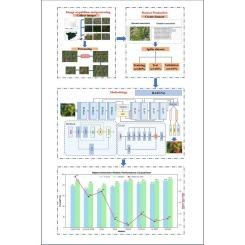松材萎蔫病多尺度小目标层次关注与特征增强网络
IF 8.9
1区 农林科学
Q1 AGRICULTURE, MULTIDISCIPLINARY
引用次数: 0
摘要
松材线虫病是一种由松材线虫引起的森林病害,严重威胁着松树的健康。这种疾病导致松树死亡,破坏森林生态系统的稳定性和生物多样性。早期发现和预防可以最大限度地提高治疗沥青溃疡病的成功率,并尽量减少其对环境的影响。因此,早期发现和控制沥青溃疡病是至关重要的。然而,现有的模型往往难以在复杂的背景环境中区分早期感染特征和噪声,从而导致高误检率。为了应对这些挑战,我们的研究引入了HAFENet,这是一种针对小型pwd感染目标量身定制的强大检测模型。HAFENet集成了一个两阶段的注意力融合模块,旨在有效地提取复杂环境中的目标特征。该模块采用自关注交叉机制,将权值学习模块处理的全局特征和局部特征融合在一起,从而更加关注小目标区域,提高模型在早期小目标检测任务中的准确率。此外,为了防止环境中的冗余特征掩盖了微妙的早期感染特征,我们设计了信息完整性卷积(IIConv)。这种双分支结构分别处理冗余和重要特征,然后利用叠加技术将它们合并,从而抑制了无关信息的干扰;此外,HAFENet还引入了解耦头来分别优化分类头和定位头。我们利用归一化Wasserstein距离为检测盒提供更有效的定位误差反馈。在我们建立的小目标PWD数据集上的验证表明,HAFENet的早期检测准确率为86.0%,晚期检测准确率为96.7%,分别比基线提高了4.3%和1.1%。与现有主流模型相比,HAFENet在松材线虫感染早期小靶点的检测准确率最高。此外,该方法在带有噪声和模糊的测试集上表现出较强的抗干扰能力。这些结果表明,HAFENet即使在具有噪声背景的恶劣环境中也能保持稳健的性能,突出了其在森林保护和管理中的广泛应用潜力。本文章由计算机程序翻译,如有差异,请以英文原文为准。

Hierarchical attention and feature enhancement network for multi-scale small targets in pine wilt disease
Pine Wilt Disease (PWD) is a forest disease caused by the pine wood nematode, which poses a serious threat to the health of pine trees. This disease leads to the death of pine trees and disrupts the stability and biodiversity of the forest ecosystem. Early detection and prevention can maximize the success rate of treating pitch canker disease and minimize its impact on the environment. Therefore, early detection and control of pitch canker disease is of utmost importance. However, existing models often struggle to distinguish the early infection characteristics from the noise in the complex background environment, resulting in a high rate of false detections. In response to these challenges, our research introduces HAFENet, a robust detection model tailored for small PWD-infected targets. HAFENet incorporates a Two-Stage Attention Fusion Module, designed to effectively extract target features in complex environments. This module adopts a self-attention cross-mechanism to fuse the global features and local features processed by the weight learning module, thereby paying more attention to small target regions and improving the model’s accuracy in early small target detection tasks. Additionally, to prevent redundant features in the environment from obscuring the subtle early infection characteristics, we designed an Information Integrity Convolution (IIConv). This dual-branch structure processes redundant and important features separately and then merges them using a stacking technique, which suppresses irrelevant information interference; Furthermore, HAFENet introduces a DeCoupled Head to separately optimize the classification and localization heads. We utilize Normalized Wasserstein Distance to provide more effective localization error feedback for detection boxes. Validation on our established small-target PWD dataset shows that HAFENet achieves an accuracy of 86.0% for early-stage detection and 96.7% for late-stage detection, representing improvements of 4.3% and 1.1% over the baseline, respectively. Compared with the existing mainstream models, HAFENet achieves the highest accuracy in the detection of small targets at the early stage of pine wood nematode infection. Additionally, it exhibits strong anti-interference capabilities on test sets with added noise and blur. These results indicate that HAFENet can maintain robust performance even in harsh environments with noisy backgrounds, highlighting its potential for wide application in forest protection and management.
求助全文
通过发布文献求助,成功后即可免费获取论文全文。
去求助
来源期刊

Computers and Electronics in Agriculture
工程技术-计算机:跨学科应用
CiteScore
15.30
自引率
14.50%
发文量
800
审稿时长
62 days
期刊介绍:
Computers and Electronics in Agriculture provides international coverage of advancements in computer hardware, software, electronic instrumentation, and control systems applied to agricultural challenges. Encompassing agronomy, horticulture, forestry, aquaculture, and animal farming, the journal publishes original papers, reviews, and applications notes. It explores the use of computers and electronics in plant or animal agricultural production, covering topics like agricultural soils, water, pests, controlled environments, and waste. The scope extends to on-farm post-harvest operations and relevant technologies, including artificial intelligence, sensors, machine vision, robotics, networking, and simulation modeling. Its companion journal, Smart Agricultural Technology, continues the focus on smart applications in production agriculture.
 求助内容:
求助内容: 应助结果提醒方式:
应助结果提醒方式:


